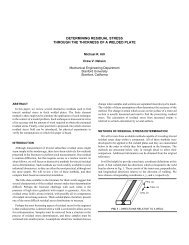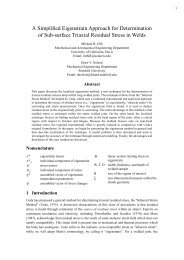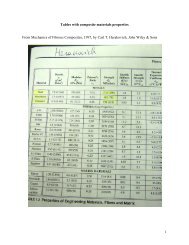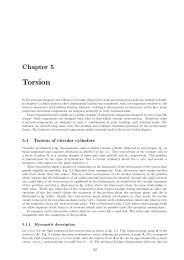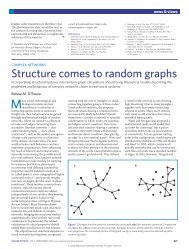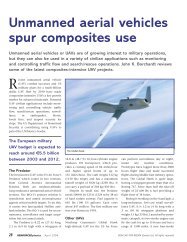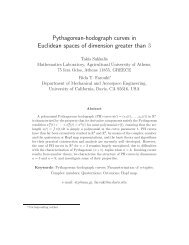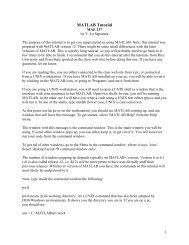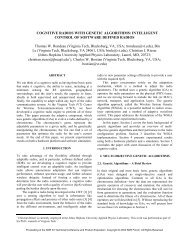Manned Sub-Orbital Space Transportation Vehicles - Department of ...
Manned Sub-Orbital Space Transportation Vehicles - Department of ...
Manned Sub-Orbital Space Transportation Vehicles - Department of ...
You also want an ePaper? Increase the reach of your titles
YUMPU automatically turns print PDFs into web optimized ePapers that Google loves.
January 2003 (Revised April 2003) AIAA 2003-0909<br />
the atmosphere or at lower combustion chamber<br />
pressures. For example, the theoretical vacuum<br />
performance <strong>of</strong> a kerosene and liquid oxygen<br />
(LOX) engine is about 350 seconds. In contrast<br />
the demonstrated Isp at sea level for the Saturn V’s<br />
F-1 engine is 265 seconds, the Delta’s RS-27 is<br />
262 seconds, and the Atlas’s MA-5 is 259 seconds.<br />
Tourist vehicles will likely have engines that<br />
operate at much lower combustion chamber<br />
pressures than these engines since most will be<br />
pressure fed instead <strong>of</strong> turbo pump fed. For<br />
example, sea level Isp for a pressure fed kerosene-<br />
LOX engine with a 250 psi (17 bar) chamber<br />
pressure is about 225 seconds.<br />
Once Isp is known, then the ideal rocket<br />
equation, which is also called Tsiolkovsky’s<br />
equation in honor <strong>of</strong> the Russian schoolteacher<br />
who first derived it over 70 years ago, indicates the<br />
maximum velocity that can be obtained from a load<br />
<strong>of</strong> propellant. It is given by the following equation:<br />
∆V = Isp go ln ( Wo / Wf ) (1)<br />
It says that the change in velocity (called delta V<br />
and symbolized by ∆V) is directly proportional to<br />
the specific impulse, Isp , multiplied by the<br />
gravitational constant, go (equals 32.174 ft/sec 2 or<br />
9.806 m/sec 2 ), and multiplied by the natural<br />
logarithm <strong>of</strong> the ratio <strong>of</strong> the weight <strong>of</strong> the rocket at<br />
take<strong>of</strong>f, Wo , and the weight <strong>of</strong> the rocket at<br />
burnout, Wf. This ratio <strong>of</strong> take<strong>of</strong>f weight to burnout<br />
weight, Wo/Wf , is called the propellant mass ratio<br />
and is sometimes written as MR. It has a value<br />
always greater than 1.<br />
When comparing design concepts, it is much<br />
easier to use propellant mass fraction, δp , which is<br />
related to propellant mass ratio, MR, by:<br />
MR = 1 / ( 1 - δp ) (2)<br />
Propellant mass fraction, δp , is defined as the<br />
amount <strong>of</strong> propellant relative to the take<strong>of</strong>f weight.<br />
For example, if the mass <strong>of</strong> a rocket at take<strong>of</strong>f is<br />
50% propellant, then its propellant mass fraction,<br />
δp , is 0.50. In this example the propellant mass<br />
ratio, MR, would be 2 since the take<strong>of</strong>f weight is<br />
twice the burnout weight.<br />
Hence if we know the propellant mass fraction,<br />
δp , and its specific impulse, Isp , we can then<br />
determine a rocket’s delta V, ∆V.<br />
Delta V Budget for <strong>Sub</strong>-<strong>Orbital</strong> Flight<br />
The next question that we need to answer is<br />
“How much delta V is needed to reach a suborbital<br />
height <strong>of</strong> 100 kilometers?” The smallest<br />
delta V to reach 100 km (328,000 ft) would be<br />
achieved by firing the launch vehicle out <strong>of</strong> a large<br />
3<br />
American Institute <strong>of</strong> Aeronautics and Astronautics<br />
cannon vertically. In the absence <strong>of</strong> an<br />
atmosphere, the cannon would have to accelerate<br />
the launch vehicle to about 4,600 feet per second<br />
(fps or 1,400 m/s) to reach 100 km above the<br />
earth’s surface. Placing this hypothetical cannon<br />
at 25,000 ft (7,600 m) altitude to represent an air<br />
launch would reduce the ideal delta V somewhat to<br />
about 4,400 fps (1,340 m/s). However, the delta V<br />
that a launch vehicle’s rocket motor must actually<br />
provide is greater than this amount because <strong>of</strong><br />
several losses.<br />
The first loss is known as the gravity loss.<br />
Gravity loss arises because part <strong>of</strong> the rocket<br />
engine’s energy is wasted holding the vehicle<br />
against the pull <strong>of</strong> Earth’s gravity (g). Gravity<br />
losses depend on the take<strong>of</strong>f thrust to weight (T/W)<br />
ratio. A T/W ratio <strong>of</strong> 1.0 means that the rocket<br />
engine’s thrust just equals the vehicle’s weight.<br />
The T/W ratio obviously needs to be greater than<br />
unity in order to climb. For launch vehicles<br />
designed to launch payloads into low earth orbit<br />
(LEO), initial T/W is in the order <strong>of</strong> 1.2 to 1.5 for<br />
liquid rockets and somewhat higher for solid<br />
rockets. Gravity losses are in the order <strong>of</strong> 2,000 to<br />
4,000 fps (600 to 1,200 m/s) for a vertical trajectory<br />
to 100 km (328,000 ft).<br />
Drag is another loss and is caused by friction<br />
between the launch vehicle and the atmosphere.<br />
Drag losses are in the order <strong>of</strong> about 500 fps (150<br />
m/s) for medium sized launch vehicles such as the<br />
Delta or Atlas rockets for an earth to orbit<br />
trajectory. A long slender cylinder with a pointed<br />
nose is a favored shape to reduce drag losses<br />
since over three-quarter <strong>of</strong> drag losses are caused<br />
by supersonic drag. Also drag losses are<br />
subjected to the “cubed-squared” law. As an<br />
object’s external dimensions increase, the surface<br />
area increases with the square <strong>of</strong> the dimension<br />
while the volume increases with the cube. Since<br />
drag is a function <strong>of</strong> surface area and not volume,<br />
then increasing the launch vehicle size will reduce<br />
drag losses. For example, the huge Saturn V<br />
moon rocket had drag losses <strong>of</strong> only 130 fps (40<br />
m/s). The cubed-squared law is the reason why<br />
launch vehicles launched from the earth’s surface<br />
should be at least 30 to 40 ft (9 to 12 m) long in<br />
order to leave the earth’s atmosphere. Otherwise<br />
drag losses are simply too high.<br />
Steering loss is the last major loss and is<br />
caused by the need to steer the launch vehicle. It<br />
arises because the instantaneous thrust vector is<br />
not always parallel to the current velocity vector.<br />
This mismatch is necessary; otherwise, it would be<br />
impossible to steer a launch vehicle. In order to<br />
get an appreciation for steering losses, the Delta II<br />
rocket has only 110 fps (34 m/s) <strong>of</strong> steering losses




